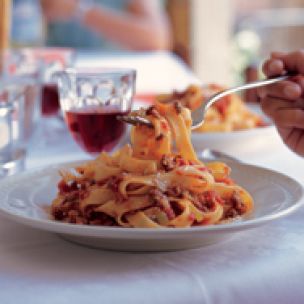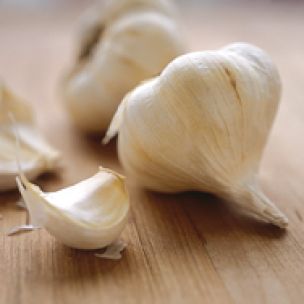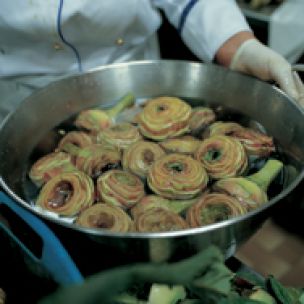
A traditional Italian pranzo (the main meal, eaten at midday) typically includes an antipasto, primo (first course), secondi (second course), with one or more contorni (side dishes) to accompany it, and a dolci (dessert) or fruit and cheese. In planning an authentic Italian meal, you can, of course, mix, match and recombine any of these fine courses to suit your own taste. But creating a multicourse menu in the time-honored, traditional Italian way allows you and your family and friends to experience the pleasure of the Italian table at its best, particularly if you are entertaining or celebrating a special occasion.
Rather than starting with the “main dish,” consider the menu as a whole, affording equal importance to each element. One good way to choose an assortment of dishes that go well together is to think regionally, or to confine your selection to dishes from northern, central, or southern Italy. Also, consider the kinds of fresh ingredients that are at their seasonal best, the tastes and preferences of your guests, and the nature of the occasion.


Choose Good Ingredients
As the popularity of the Mediterranean diet and the flavors of Italy continue to grow, more and more well-stocked supermarkets are carrying Italian artisanal foods. Seeking out these ingredients will make a huge difference as you prepare Italian recipes, because they do much of the work of cooking for you. Good-quality pancetta or prosciutto, aged pecorino romano or Parmigian-Reggiano cheese, small, delicate lentils – raw materials like these add complexity and authenticity without adding a lot of work.

Prepare In Advance
At a typical Italian meal, most of the food is cooked well ahead of time. The antipasto is set out on platters or multiple small plates, and the second course is usually finished and ready to be served. The side dishes are fully cooked and standing by, often to be enjoyed at room temperature. The pasta sauce is simmering gently, and the pasta water is at a rolling boil. Wine is opened and ready to pour along with still and sparkling water.
It is generally only the cooking and saucing of the pasta that are left for the last minute. This strategy works particularly well for entertaining, because it means that you can serve even a relatively complicated menu with minimal stress, since almost all of the work is done before the guests arrive.


Pairing Wines with Italian Food
When choosing wines to enjoy with Italian foods, consider the regional origins of a dish and try to select a wine from the same region. Keep in mind the season and the recipes you are preparing when you choose a wine. In general, lighter dishes usually call for lighter wines. You can also choose a vino da tavola (Italian table wine), which tends to be affordable and pairs well with a variety of flavors. And, of course, many non-Italian wines make perfect matches for Italian foods. When in doubt, ask a trusted wine merchant for suggestions.












